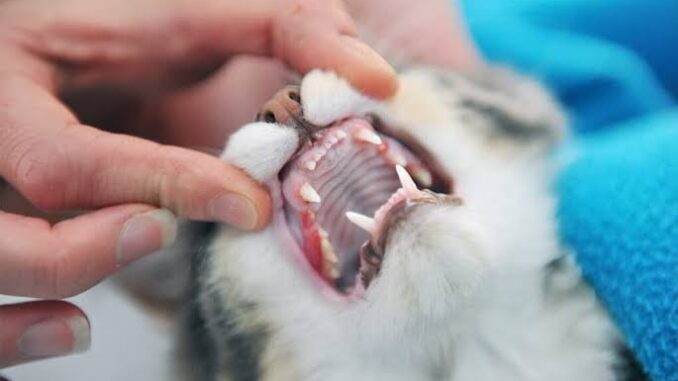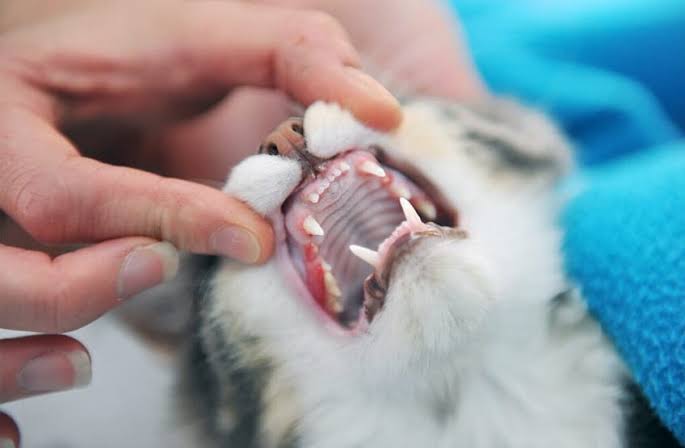
How to Keep Your Cat’s Teeth Clean: Cats are known for their independence and cleanliness, but when it comes to dental hygiene, they need a little help. While it may not be the most glamorous part of pet ownership, taking care of your cat’s teeth is essential to their overall health and longevity.

Dental disease is one of the most common health issues in cats by the age of three, over 70% of cats show signs of dental problems such as gingivitis or tartar buildup. Without proper care, these can lead to pain, tooth loss, and even systemic illnesses affecting the kidneys, liver, and heart.
This comprehensive guide will walk you through the importance of feline dental care, how to maintain your cat’s oral hygiene at home, and what to expect from professional dental cleanings.
Why Cat Dental Hygiene Matters
A cat’s mouth is full of bacteria, and without regular cleaning, plaque can build up on their teeth. Over time, this plaque hardens into tartar, which can lead to inflammation of the gums (gingivitis), infection, and even tooth loss. Worse still, bacteria from the mouth can enter the bloodstream and affect major organs.
Signs of dental problems in cats:
- Bad breath
- Red or bleeding gums
- Drooling or pawing at the mouth
- Difficulty eating or chewing on one side
- Loose or missing teeth
- Visible tartar on the teeth
Preventative care is the key to avoiding costly and painful dental issues down the road.
How to Clean Your Cat’s Teeth at Home
1. Daily Brushing (The Gold Standard)
Brushing your cat’s teeth daily is the most effective way to prevent plaque and tartar buildup. While this may sound daunting, many cats can be trained to tolerate it—some even come to enjoy it.
Steps to brush your cat’s teeth:
- Start Slow: Get your cat comfortable with having their mouth touched. Begin by gently rubbing their cheeks and lifting their lips.
- Use Cat-Specific Tools: Never use human toothpaste—it can be toxic to cats. Use enzymatic cat toothpaste and a finger brush or soft-bristled cat toothbrush.
- Go Gradually: Let your cat lick the toothpaste off your finger at first. Then slowly start brushing a few teeth at a time.
- Reward with Treats: Positive reinforcement helps your cat associate brushing with something good.
Even brushing a few times a week can make a big difference if daily brushing isn’t realistic.
2. Dental Treats and Chews
Dental treats are specially designed to help remove plaque through mechanical chewing. Look for products approved by the Veterinary Oral Health Council (VOHC). These treats can supplement brushing or be an alternative if your cat won’t tolerate brushing.
Popular options include:
- Greenies Feline Dental Treats
- Purina Dentalife Dental Cat Treats
- Virbac C.E.T. Oral Hygiene Chews
These treats work best when given daily.
3. Dental Gels and Water Additives
If brushing isn’t an option, dental gels can help break down plaque and reduce bacteria. These are applied to the gums or teeth using your finger or a cotton swab.
Water additives are another easy-to-use product that mixes with your cat’s drinking water. They help control plaque and freshen breath.
Recommended products:
- TropiClean Fresh Breath Oral Care Gel
- Oxyfresh Dental Water Additive
- Vet’s Best Dental Gel for Cats
Always choose products formulated specifically for cats, and consult your vet before introducing new oral care items.
4. Dental Diets
Some veterinary diets are formulated to promote oral health. These often have a special kibble texture that scrapes away plaque and tartar as the cat chews.
Common prescription diets include:
- Hill’s Prescription Diet t/d Dental Care
- Royal Canin Dental Diet for Cats
These should only be used under your veterinarian’s guidance.
READ ALSO: The Best Catnip Toys for Feline Fun
Professional Dental Cleaning
Even with the best home care, most cats will need professional dental cleanings at some point. These cleanings are performed under general anesthesia and involve:
- Thorough examination of teeth and gums
- Scaling to remove tartar above and below the gumline
- Polishing the teeth to slow plaque buildup
- Dental X-rays to check for hidden issues
Your vet may also extract damaged or infected teeth if necessary.
How often are professional cleanings needed?
It varies by age, breed, and genetics, but most cats benefit from a cleaning every 1–2 years. Your vet will assess your cat’s needs during regular checkups.
Natural and DIY Approaches (With Caution)
Some cat owners explore natural dental care, such as raw bones or homemade oral sprays. While raw chicken necks or bones can help with mechanical cleaning, they carry risks of choking, tooth fractures, or bacterial contamination. Always talk to your vet before trying any DIY solutions.
Establishing a Dental Routine
- Start young: Kittens adapt more easily to tooth brushing.
- Be consistent: Make dental care part of your daily or weekly routine.
- Observe changes: Monitor your cat for signs of dental disease.
- Combine methods: Brushing, treats, gels, and vet care work best in tandem.
Breeds Prone to Dental Issues
Some breeds are more susceptible to dental problems, especially:
- Persians and Himalayans (due to flat faces and crowded teeth)
- Siamese and other Oriental breeds
- Abyssinians
These breeds may require more frequent cleanings and diligent home care.
FAQs
How often should I brush my cat’s teeth?
Ideally, daily. But if that’s not possible, aim for at least 3–4 times a week to significantly reduce plaque buildup.
What if my cat absolutely refuses tooth brushing?
Try using a combination of dental treats, water additives, and gels. You can also consult your vet for tips or try feline behavior modification strategies.
Are human toothpastes safe for cats?
No. Most human toothpastes contain fluoride or xylitol, which are toxic to cats. Only use toothpaste specifically formulated for cats.
How do I know if my cat needs a dental cleaning?
Signs include bad breath, visible tartar, gum redness, or difficulty eating. Your vet can confirm during an exam if a cleaning is needed.
Do indoor cats still need dental care?
Yes. Whether indoors or outdoors, all cats are susceptible to dental disease. Diet and genetics play a larger role than lifestyle.
Is anesthesia necessary for dental cleanings?
Yes, professional cleanings are done under general anesthesia to ensure your cat remains still and pain-free. This allows the vet to clean below the gumline and take X-rays.
Can dental disease affect other organs?
Yes. Bacteria from gum infections can enter the bloodstream and damage the heart, liver, or kidneys, especially in older cats.
Leave a Reply
You must be logged in to post a comment.